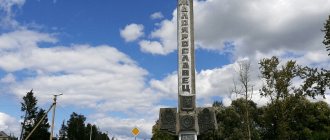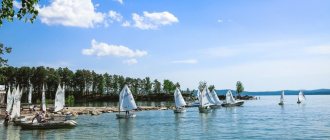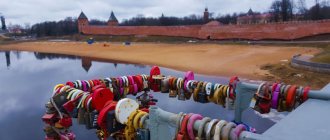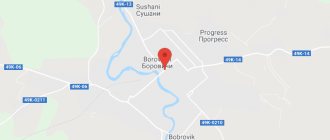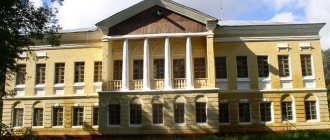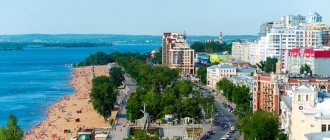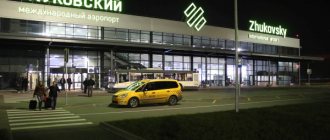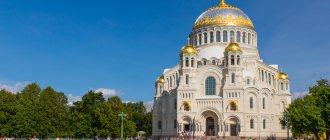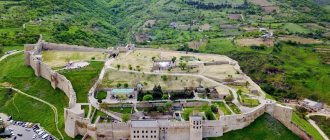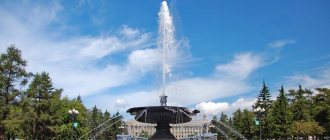Vitebsk is an ancient Eastern European city. It stands at the confluence of two rivers - the Western Dvina and Vitba. He got his name from the latter. Vitebsk is more than a thousand years old - according to urban legend, its founder was Princess Olga.
It became part of the Russian Empire in 1772 after the partition of Poland, and before that it belonged to the Grand Duchy of Lithuania, then to the Polish-Lithuanian Commonwealth. Now Vitebsk is the regional center of the Republic of Belarus.
Today Vitebsk is famous for its arts festival “Slavic Bazaar”. In addition, the city is the birthplace of Marc Chagall, an avant-garde artist.
Many interesting places around Vitebsk and what other cities in Belarus are a must-see: in a large guide to the country.
Historical sites and museums
House-Museum of Marc Chagall
Address: st. Pokrovskaya, 11 Phone: +375 Website: chagal-vitebsk.com Opening hours: Tue-Sun 11:00-18:30 Cost: adults - 2.5 bel. rub., schoolchildren and students - 1.5 bel. r., excursion - 12 bel. R.
The opening of the museum took place in 1997 and was timed to coincide with the 110th anniversary of the artist’s birth. On Pokrovskaya Street, where the museum is now located, Chagall’s parents owned four houses: one stone and three wooden, although the family was considered poor.
The wooden buildings did not survive to this day, and the stone building became the Marc Chagall Memorial Museum. Each of the five rooms of the museum has its own name:
- Grocery. Nowadays you can buy souvenirs with images of Chagall’s paintings, books, and postcards here. The shop has an owner - a doll figurine of Feiga-Ita, Mark's mother, who once sold herring and small groceries here.
- Boys' room. Presumably, it was in this room that Mark lived with his brother David before his departure. Here visitors are told about the Vitebsk period of the artist’s life.
- Living room with a recreated interior of a Jewish home.
- Red room. Everything here is done in red and burgundy tones. There are many things that are in tune with the era of the early 20th century. Photographs from Chagall's family archive are presented, telling about the artist's life from his first days in Paris until his death in 1985. The museum enjoys the exclusive right to display these photographs, granted by the painter’s heirs.
- The kitchen conveys the flavor of family life in a provincial town of the past. From the kitchen you can access the garden with fruit trees, flower beds and a Chagall sculpture.
Vitebsk Town Hall
Address: st. Lenina, 36 Telephone: Opening hours: Tue-Sun 10:00 - 18:00 Cost: adults - 5 bel. r., schoolchildren and students - 2 bel. R. 50 kopecks
In medieval Europe, town halls were built in cities that had self-government. This privilege was ensured by Magdeburg Law, granted to Vitebsk in 1597. A wooden town hall was built on the market square for meetings of the city council, the magistrate. Since then, the building has burned down more than once, been destroyed, rebuilt, and again perished in a fire, until in the 70s of the 18th century the townspeople built a stone town hall.
Throughout its existence, the town hall has housed a city government, a city court, a police department, and even a fire yard. With this in mind, the town hall is sometimes called the tower. Architecturally, the building is a mixture of styles; it was rebuilt many times, each era bringing something different to the appearance of the building.
Since 1924, the town hall has housed a local history museum. Among its exhibitions there is an exhibition of treasures found in the Vitebsk region. In summer, you can look out over the city from the observation deck of the town hall.
Old city
Address: pedestrian part of the city, Vzgorye
The city began with an unfortified settlement, huddled near the walls of the Vitebsk castles, Nizhny and Upper. After the city was granted Magdeburg Law, its real development began. A town hall, a guest courtyard, churches, monasteries, and mills were built. The area is surrounded by wooden walls with towers.
The Old Town area was created as an architectural monument of the 17th and 18th centuries. The street layout of that time, residential buildings, characteristic of Vitebsk in a burgundy shade (the color of the local clay) have been preserved here. The ensemble of the Town Hall Square is also included in this historical zone. The churches of the Old Town were built in the Vilnius Baroque style. The Catholic Church was also supposed to be included in this zone, but was blown up to expand Lenin Street. You can stay in a hotel in the Old Town after studying reviews of hotels in Vitebsk.
In autumn, a village fair is held right on the central square.
Governor's Palace of Vitebsk
Address: st. Sovetskaya, 18
An architectural monument of the 18th century. It was the residence of the governors of the Vitebsk province. The palace is associated with famous historical figures. In 1812, Napoleon I Bonaparte stayed there. Here he decided to suspend the attack on Moscow and wait out the winter, but two weeks later he advanced to Smolensk.
Russian imperial persons also visited the palace: Nicholas I’s brother, Grand Duke Konstantin Pavlovich, Tsarevich Alexander Nikolaevich (future Emperor Alexander II).
Ivan Lazhechnikov, the first Russian historical novelist, who served as Vitebsk vice-governor, lived in the palace. True, he was not delighted with the city, he spoke of it as a “strange and trashy town,” which did not stop him from writing several works here.
During World War II, the palace was almost completely destroyed. Only the walls survived. Restored in peacetime.
The building houses the KGB department of the Republic of Belarus, so you can only see it from the outside.
Museum of the History of Vitebsk Tram
Address: 5th st. Frunze, 7 Phone: , Opening hours: Mon-Fri 8:00-17:00
Vitebsk is the first city in Belarus where a tram appeared earlier than in Moscow and St. Petersburg. The museum arose thanks to the head of the personnel department of the tram department L.A. Zabello in 1966.
Since 2002, the museum has been named folk museum. Five sections of the museum tell how tram traffic developed in the city, and how the tram itself changed.
The tram park has real working vintage trams that you can ride on weekends and holidays.
Art Museum
Address: st. Lenina, 32 Phone: +375, +375 (212) 36-63-01 Opening hours: Tue-Sun 10:00-18:00 Cost: adults - 5 bel. r., schoolchildren and students - 2 bel. R. 50 kopecks
Located in the former county courthouse, built in the late 19th century in classical style. The museum presents:
- permanent exhibitions of graphics and painting;
- works by artists from the Vitebsk Art College;
- Belarusian embroidery of the early 19th century;
- 18th century dishes from local manufactories;
- works by I. Pan, P. Yavich, F. Gumen.
Dukhovsky roundabout
Address: Frunze Avenue, 11a Phone: +375 Website: gck.by Opening hours: Wed-Sun 10:00-18:00 Cost: adults - 5 bel. r., schoolchildren and students - 2 bel. R. 50 kopecks
An exhibition hall stylized as a medieval watchtower. The prototype for it was a high wooden tower, added in the 17th century to the Lower Castle during the time of Prince Olgerd and called the Dukhovskaya Kruglik.
Today the tower is a modern spacious building, on five levels of which there are:
- an exhibition dedicated to archaeological excavations at this site;
- historical museum of the city;
- collection of the festival "Slavic Bazaar";
- Observation deck.
Square of victory
This is the largest square in all of Belarus, and not just in Vitebsk. It is divided by Lenin Street. This leaves on one side an area for major events, and on the other a memorial complex with an awe-inspiring monument known as the Three Bayonets.
Square of victory
- GPS coordinates: 55°10′58.80″ N. latitude, 30°12′14.40″ e. d.
Parks and monuments, streets
Memorial complex "Three bayonets"
Address: Victory Square
Monument to Soviet soldiers-liberators, partisans and underground fighters - the three forces that defeated the enemy. From Victory Square, where the monument is located, three stairs descend to the Western Dvina.
In the evenings the complex is illuminated.
Residents call the complex “treshka”.
Monument to Prince Olgerd
Address: Market Square
The monument adorns the historical center of the city.
Olgerd, Grand Duke of Lithuania - founder of Vitebsk castles. He was married to Vitebsk Princess Maria. He turned a small settlement into a castle town with stone walls and churches. During the years of the prince's reign, the territory of the principality doubled.
The prince achieved great influence in the Novgorod and Smolensk lands. Residents of Pskov invited Olgerd for protection from the Livonian knights. Olgerd was the first to defeat the Tatars at the Battle of Blue Waters in 1362. During the reign of Olgerd there were no popular unrest, which speaks of the wisdom of the ruler.
The equestrian sculpture depicts Olgerd riding out of the castle, a falcon on his hand - as a message from the prince to his descendants. The monument is called the Vitebsk Bronze Horseman.
Vitebsk giant
Address: Mayakovsky Square near the town hall
Monument to the tallest man in the world, Fyodor Makhnov. His height was 2 m 85 cm. More precisely, this is an artistic interpretation of a real image. Money for the monument was collected at city cleanup days.
The Belarusian Gulliver is depicted in full growth. The height of the figure together with the cylinder is 3m 20cm. Fyodor Makhnov was born in the Belarusian village of Kostyuki. In his youth, he was invited to Germany to perform in a circus. In Europe, the giant was a public favorite. After 9 years of working in the circus, Fedor became a wealthy man. During a family trip to Europe, Fedor and his family were granted an audience by the Pope. According to family legend, he gave the giant’s daughter Maria a gold cross, which during the war, in order to escape poverty, relatives had to sell.
In 1912, Fyodor Makhnov died. He was 34 years old. He was buried in the village cemetery.
But there is no body in the grave. The teachers of the medical institute, where Fyodor’s son Rodion studied, persuaded him to sell the giant’s skeleton for 5,000 rubles. The family was in need, and the offer was accepted. During the war the remains disappeared.
Botanical Garden of Vitebsk
Address: st. Uritskogo/st. Communist Telephone: Opening hours: daily 08:30-20:00
University park. Located on the banks of Vitba. It is not only a place for walking, but also a scientific department of the local university.
The park’s collection of plant species is the second largest in Belarus. In the park you can buy seedlings of flowers and trees.
Botanical Garden
The botanical garden was created for schoolchildren. The oldest linden trees located here are about a hundred years old. The official date of creation is 1919. It was planned that children would be able to study nature in this way. Environmental conditions make it possible to grow the most demanding plants, of which there are about 2.5 thousand. Nearby are the Vitba river and two ponds.
Botanical Garden
Although the botanical garden was damaged during the Great Patriotic War, it was soon restored and given over to the care of the local university. The territory of the facility is 4 hectares. There are also greenhouses and an arboretum. You can walk around the botanical garden freely; paid entry is only for some areas, for example, the greenhouse and the area with rare collection plants.
- Address : corner of Kommunisticheskaya and Uritsky streets.
- Opening hours: daily from 8:30 to 20:00.
Churches and temples
Holy Assumption Cathedral
Address: st. Krylova, 9 Telephone: Opening hours: daily 7:00-19:00
The Orthodox Cathedral stands on Assumption Hill. Previously, the mountain was called Lysa, and there were pagan sanctuaries on it. The Orthodox Prechistenskaya Church, built here, having become Uniate, was destroyed by the rebel townspeople. Then a monastery with a church for the Basilians was built in the image of a Roman temple. With the abolition of the monastery, the church became an Orthodox cathedral. In 1936, the Soviets blew up the cathedral.
The modern Assumption Cathedral was built, trying to replicate the structure of the 18th century.
The cathedral has a legend about the existence of underground passages to the river. This legend is explained by the fact that in the 18th century the builders provided a whole drainage system for draining water from the basements of the cathedral into the river. The vaults of this system were high, and the builders worked conscientiously, so the passages were preserved and became overgrown with legends.
The temple is decorated with the largest bell in Belarus. Its weight is 5.2 tons, height - 2 meters.
Holy Resurrection Church
Address: st. Suvorova, 2 Opening hours: daily 07:00-19:00
Built in 2009 on the site of one destroyed in 1936. The Church of the Resurrection was first mentioned in the 17th century, when it was still wooden.
The first stone church on this site was Uniate, built in the “Vilna” Baroque style.
Roman Catholic Church of St. Barbara
Address: st. Leningradskaya, 27 Opening hours: daily 07:00-19:00
The Catholic church was built with the money of Marshal (leader of the nobility) Anthony Kosov in 1785.
The territory is well-groomed, the decoration of the church is quite simple, even ascetic.
Services are conducted in different languages. Photography is not prohibited. On Thursdays, youth meetings are held in the church.
Governor's Palace
Another object reminiscent of the neoclassical era. The palace was built in the 18th century. Regional governors worked here. The building is well maintained and is adjacent to a zoo and a park. You can admire the palace from the outside for free, but it’s better not to go inside: it has now become a branch of the KGB department of the republic.
Governor's Palace
Interesting fact ! Napoleon stayed at the Governor's Palace in 1812 while going to war against Moscow.
- Address: Sovetskaya street, 18 (on the left bank of the Western Dvina).
Entertainment
"Slavic Marketplace"
Address: main festival site - st. Frunze, 13a Website: fest-sbv.ru
International Arts Festival. It was first held in 1992. During the collapse of the Soviet Union, it was called upon to revive the community of cultures of the Slavic peoples. The founders were non-profit private organizations from Belarus, Russia and Ukraine.
The main venue of the festival is the summer amphitheater, and the main competition is for pop song performers. Winning the competition is considered a prestigious award.
The XXVIII International Festival “Slavic Bazaar in Vitebsk” will be held from July 9 to July 17, 2021.
Zoo
Address: st. Kupala, 17 Telephone: Opening hours: Tue-Fri 10:00-17:00, Sat, Sun 10:00-18:00 Cost: under 3 years old - 0, from 3 to 12 years old - 3 bel. r., over 12 years old - 4 bel. R.
Located in the city center. Storks and geese roam freely around the area.
There is a Red Book animal of the Republic of Belarus in the zoo - the bison Borka.
Reviews from tourists
- Alexander, Saratov
Vitebsk is a clean and beautiful city. People here respect their history and care about preserving their cultural heritage. I liked the fact that the city has many museums and restored historical and architectural monuments.
- Daria, Ufa
I like the fact that the city is surrounded by greenery. There are many fountains in parks and squares. The city also has several rivers and reservoirs with picturesque views.
- Igor, Syzran
I came here a year ago and received a lot of positive impressions.
There are many very beautiful churches in Vitebsk, unfortunately, I didn’t even have time to see them all. I also went to the Slavic Bazaar, it was indescribable. I highly recommend coming here, especially in the summer. Vitebsk is a city with amazing architecture and interesting sights.
Most of the sights of Vitebsk cannot be seen in 1 day, but in 2 days it’s quite possible. The city is perfect for a weekend getaway and you'll definitely find something to see.
Attractions in the surrounding area
Berezinsky Biosphere Reserve
Coordinates: 54.741000, 28.320018 Address: Vitebsk region, Lepel district, Domzheritsy, st. Tsentralnaya, 3 Website: www.berezinsky.ru How to get there: minibus from the bus station in Minsk and Vitebsk to the village of Domzheritsy
The reserve has been operating for almost 100 years. You can come here and watch animals in natural conditions. You can pre-book an excursion, for example, to a forest zoo, where wild animals live in large enclosures.
Gazebos are available for relaxation. There is the Serguch Hotel with comfortable rooms and a restaurant that serves game caught in the hunting grounds next to the reserve. In the Forest Fun complex on the territory of the reserve you can do extreme sports. There are suspension bridges and rope crossings.
For walking, you can rent bicycles, electric cars, and ATVs. During the warm season, there are walking tours on the territory of the reserve. There is an opportunity to go horseback riding or kayak along the rivers and lakes of the reserve.
Let's sum it up
As you can see, Vitebsk really is one of the most interesting historical Belarusian places. The city lives with the memories of two outstanding artists, and tourists try to learn more about their lives and activities. The largest event in Vitebsk is the Slavic Bazaar. In addition, this Belarusian regional center has a cozy feel, and the surrounding area reminds of the wealth of natural resources, including flora and fauna.
If you are exploring Belarusian sights and have a lot of time, you can stop by the capital. Of course, in Minsk you can mainly look at the modern benefits of civilization. But this is also necessary.
Zdravnevo
If we talk about the sights of Vitebsk and its surroundings, then you should definitely visit the estate of the famous artist I. E. Repin. This wooden manor is of great architectural value. Repin acquired this plot in 1982, and under his leadership the estate changed dramatically, undergoing a major reconstruction.
The most interesting part of the Repin building is considered to be a high tower with wide terraces and balconies; the inside of the building is distinguished by its unusual decoration. At the moment, the house is located on the territory of a picturesque park, near the water, among centuries-old linden trees, which Ilya Efimovich himself planted.
Amphitheater
Look at this photo. A Vitebsk landmark, the calling card of the city, is this majestic, modern summer amphitheater. The building is relatively new, the year of its construction is 1988, it is the main venue for the Slavic Bazaar and many concerts of popular performers.
An interesting fact: the construction site was not chosen by chance; before the amphitheater, in this picturesque place, in the park, by the stream, there was Lerry's circus, which was often depicted by M. Chagall's teacher - Y. Pena.
Restaurants
Vitebsk has a wide selection of restaurants for different tastes. Don’t know where to go in Vitebsk, where to have a delicious lunch, try out new cuisine or drink a cup of aromatic coffee? The most comfortable and popular restaurant in Vitebsk is the “Golden Dragon” - this is the only establishment in the city that specializes in preparing exclusively classic Chinese dishes. It is worth saying that the interior of the restaurant is made in the best traditions of Eastern culture.
For lovers of European cuisine, there is an equally popular restaurant, the Gubernsky Tavern, whose menu includes the most popular dishes in Europe. The restaurant will appeal to those who love delicious food and cannot do without exciting entertainment. In the evenings, the restaurant is filled with live music, and the dance floors come to life.
Where can a tourist go in Vitebsk to taste national cuisine? "Lyamus" is a restaurant with appropriately refined natural wood finishes and incomparable decor. The most delicious dishes of Belarusian cuisine are served here.
Vitebsk is a small city in the north of Belarus - the pride of the Belarusian people, there are plenty of places to go. Vitebsk is a friendly and hospitable city; at any time of the year, all well-maintained parks, restored temples and churches, theaters and restaurants are open for you.
